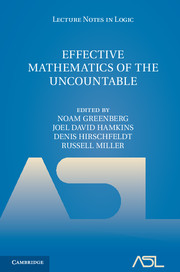Refine search
Actions for selected content:
5849 results in Programming Languages and Applied Logic
References
-
- Book:
- Foundations of Data Exchange
- Published online:
- 05 June 2014
- Print publication:
- 06 March 2014, pp 321-326
-
- Chapter
- Export citation
22 - Endnotes to Part Four
- from Part Four - METADATA MANAGEMENT
-
- Book:
- Foundations of Data Exchange
- Published online:
- 05 June 2014
- Print publication:
- 06 March 2014, pp 312-320
-
- Chapter
- Export citation
Part Three - XML DATA EXCHANGE
-
- Book:
- Foundations of Data Exchange
- Published online:
- 05 June 2014
- Print publication:
- 06 March 2014, pp 133-134
-
- Chapter
- Export citation
12 - Building solutions
- from Part Three - XML DATA EXCHANGE
-
- Book:
- Foundations of Data Exchange
- Published online:
- 05 June 2014
- Print publication:
- 06 March 2014, pp 158-181
-
- Chapter
- Export citation
13 - Answering tuple queries
- from Part Three - XML DATA EXCHANGE
-
- Book:
- Foundations of Data Exchange
- Published online:
- 05 June 2014
- Print publication:
- 06 March 2014, pp 182-192
-
- Chapter
- Export citation
11 - Patterns and mappings
- from Part Three - XML DATA EXCHANGE
-
- Book:
- Foundations of Data Exchange
- Published online:
- 05 June 2014
- Print publication:
- 06 March 2014, pp 143-157
-
- Chapter
- Export citation
4 - The problem of relational data exchange
- from Part Two - RELATIONAL DATA EXCHANGE
-
- Book:
- Foundations of Data Exchange
- Published online:
- 05 June 2014
- Print publication:
- 06 March 2014, pp 35-42
-
- Chapter
- Export citation
8 - Alternative semantics
- from Part Two - RELATIONAL DATA EXCHANGE
-
- Book:
- Foundations of Data Exchange
- Published online:
- 05 June 2014
- Print publication:
- 06 March 2014, pp 97-123
-
- Chapter
- Export citation
2 - Theoretical background
- from Part One - GETTING STARTED
-
- Book:
- Foundations of Data Exchange
- Published online:
- 05 June 2014
- Print publication:
- 06 March 2014, pp 12-28
-
- Chapter
- Export citation
1 - Data exchange by example
- from Part One - GETTING STARTED
-
- Book:
- Foundations of Data Exchange
- Published online:
- 05 June 2014
- Print publication:
- 06 March 2014, pp 3-11
-
- Chapter
- Export citation

Effective Mathematics of the Uncountable
-
- Published online:
- 05 December 2013
- Print publication:
- 31 October 2013
9 - Completeness Using Canonical Models
-
- Book:
- Modal Logic for Philosophers
- Published online:
- 05 June 2014
- Print publication:
- 25 November 2013, pp 193-208
-
- Chapter
- Export citation
Contents
-
- Book:
- Modal Logic for Philosophers
- Published online:
- 05 June 2014
- Print publication:
- 25 November 2013, pp v-x
-
- Chapter
- Export citation
7 - Converting Trees to Proofs
-
- Book:
- Modal Logic for Philosophers
- Published online:
- 05 June 2014
- Print publication:
- 25 November 2013, pp 134-169
-
- Chapter
- Export citation
16 - Completeness of Quantified Modal Logics Using Trees
-
- Book:
- Modal Logic for Philosophers
- Published online:
- 05 June 2014
- Print publication:
- 25 November 2013, pp 354-362
-
- Chapter
- Export citation
8 - Adequacy of Propositional Modal Logics
-
- Book:
- Modal Logic for Philosophers
- Published online:
- 05 June 2014
- Print publication:
- 25 November 2013, pp 170-192
-
- Chapter
- Export citation
Frontmatter
-
- Book:
- Modal Logic for Philosophers
- Published online:
- 05 June 2014
- Print publication:
- 25 November 2013, pp i-iv
-
- Chapter
- Export citation
Bibliography of Works Cited
-
- Book:
- Modal Logic for Philosophers
- Published online:
- 05 June 2014
- Print publication:
- 25 November 2013, pp 477-480
-
- Chapter
- Export citation
6 - Trees for Extensions of K
-
- Book:
- Modal Logic for Philosophers
- Published online:
- 05 June 2014
- Print publication:
- 25 November 2013, pp 114-133
-
- Chapter
- Export citation
Preface
-
- Book:
- Modal Logic for Philosophers
- Published online:
- 05 June 2014
- Print publication:
- 25 November 2013, pp xiii-xvi
-
- Chapter
- Export citation
